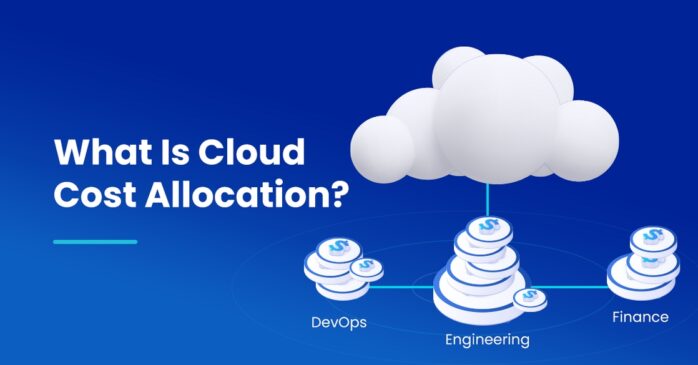
In today’s rapidly evolving digital landscape, cloud computing has emerged as a game-changer, providing businesses and individuals with scalable and flexible computing resources. Cloud allocation is crucial in maximizing the efficiency and cost-effectiveness of cloud computing environments.
This blog post explores cloud cost allocation and how it optimizes resources in the digital sky.
Understanding Cloud Allocation:
Cloud allocation refers to assigning and distributing computing resources within a cloud infrastructure to meet the demands of users and applications effectively. These resources typically include virtual machines (VMs), storage, network bandwidth, and other components necessary to run cloud applications.

Optimizing Resource Utilization:
One of the primary goals of cloud allocation is to optimize resource utilization. Cloud service providers employ sophisticated algorithms and intelligent techniques to allocate resources based on real-time demand and workload characteristics. By dynamically adjusting the allocation of resources, cloud providers can ensure that applications receive the necessary resources while minimizing waste and inefficiencies.
What Are Cloud Allocation Tags?
Cloud allocation tags, also known as resource tags or metadata tags, are labels or identifiers attached to cloud resources within a cloud computing environment. These tags provide additional information about the resources and are used for organizing, categorizing, and managing them effectively. Cloud providers offer tag-based allocation mechanisms to simplify resource allocation and enable more granular control over resource management.
Here are some key aspects of cloud allocation tags:
- Organization and Categorization: Allocation tags allow users to organize and categorize cloud resources based on specific criteria or attributes. For example, tags can identify resources belonging to a particular project, department, or cost center.
- Resource Allocation and Cost Allocation: Tags define resource allocation policies and accurately enable cloud cost allocation to different departments or projects.
- Automation and Resource Management: Cloud allocation tags automate resource management by serving as criteria for provisioning, scaling, and de-provisioning workflows, such as dynamic resource allocation based on workload demands.
- Access Control and Security: Tags can be utilized to define resource-level permissions, ensuring that only authorized users or groups can access or modify specific resources. This enhances security and helps enforce compliance with organizational policies.
- Cost Optimization and Reporting: By analyzing resource usage based on tags, businesses can identify cost-saving opportunities, optimize resource allocation, and generate detailed cost reports for different departments, projects, or customer accounts.
Cloud providers, such as Amazon Web Services (AWS) and Microsoft Azure, offer specific tag management services and APIs that allow users to assign, manage, and leverage allocation tags effectively. Establishing a consistent and well-defined tagging strategy is essential to maximize the benefits of cloud allocation tags and ensure proper resource organization, control, and cost management within a cloud computing environment.

Key Benefits of Cloud Allocation:
- Scalability: Cloud allocation enables businesses to scale their resources up or down as needed. During periods of high demand, resources can be quickly allocated to accommodate increased workloads. Conversely, during periods of low demand, resources can be reallocated to avoid unnecessary costs.
- Cost Optimization: By efficiently allocating resources, cloud allocation helps optimize costs. Businesses can avoid over-provisioning, which occurs when resources are allocated but remain underutilized. Cloud providers often offer pay-per-use models, allowing users to pay only for the resources they consume.
- Performance Enhancement: Effective cloud allocation ensures applications receive the necessary resources to operate optimally. By dynamically allocating resources based on workload demands, businesses can enhance application performance, reduce response times, and improve overall user experience.
- Resource Isolation: Cloud allocation also facilitates resource isolation, ensuring that different users or applications do not interfere with each other’s performance. Cloud providers can prevent resource contention and ensure consistent user performance by allocating dedicated resources or employing virtualization techniques.
- Flexibility and Agility: Cloud allocation allows businesses to adapt and respond quickly to changing requirements. Resources can be provisioned, de-provisioned, or reallocated on-demand, enabling organizations to rapidly scale their operations or experiment with new applications and services.
Examples of Successful Cloud Cost Allocation Strategies;
Successful cloud cost allocation strategies vary depending on the organization’s needs and goals. Here are a few examples of effective strategies:
- Tag-based Cost Allocation:
- Showback/Chargeback Models
- Cost Allocation by Usage Metrics
- Shared Cost Pools
- Hybrid Cost Allocation
- Automated Cost Allocation Tools
It’s important to note that each organization has unique requirements and considerations when it comes to cost allocation. Choosing the most appropriate strategy involves understanding the organization’s structure, objectives, and resource usage patterns, and may require adjustments and fine-tuning over time.

Alternatives to Cloud Cost Allocation and Their Pros and Cons;
While cloud cost allocation is a common approach to managing and distributing cloud expenses, there are alternative strategies organizations can consider. Here are a few alternatives along with their pros and cons:
-
Budget-Based Allocation:
- Pro: Allocate fixed budgets to different departments or teams without granular cost tracking. This approach provides autonomy to teams to manage their cloud resources within the allocated budget.
- Con: Lack of cost visibility and granularity may result in inefficient resource utilization and difficulty in identifying cost-saving opportunities. It can also lead to challenges in accurately attributing costs to specific activities or projects.
-
Resource Ownership:
- Pro: Assign ownership of cloud resources to different departments or teams. Each department is responsible for managing and optimizing its assigned resources and associated costs.
- Con: This approach requires clear ownership guidelines and coordination to avoid duplication or underutilization of resources. It may not provide detailed cost visibility or facilitate control beyond resource ownership boundaries.
-
Cost Awareness and Education:
- Pro: Promote cost awareness and educate employees about cloud costs. This approach encourages responsible cloud resource usage, cost-conscious decision-making, and identification of optimization opportunities.
- Con: It may not provide a direct mechanism for cost allocation and distribution among departments or teams. It relies on individual understanding and self-regulation, which may be challenging to enforce consistently across the organization.
Each alternative strategy has its own benefits and drawbacks. Organizations should consider their specific needs, resource utilization patterns, cost visibility requirements, and organizational structure when selecting the most appropriate approach or combination of approaches. It’s important to regularly evaluate the chosen strategy’s effectiveness and adjust as needed.
Challenges and Considerations;
While cloud allocation offers numerous benefits, there are some challenges and considerations to keep in mind:
- Resource Sizing: Determining the appropriate size and allocation of resources requires careful planning and analysis. Over- or under-provisioning can lead to inefficiencies or performance bottlenecks.
- Monitoring and Optimization: Continuous resource utilization monitoring is essential to identify potential bottlenecks or underutilized resources. Optimization efforts should focus on adjusting allocations to match evolving workload patterns.
- Security and Compliance: When allocating resources, ensuring data security and compliance with regulatory requirements should be top priorities. Access controls, encryption, and compliance frameworks must be implemented to protect sensitive information.

Conclusion:
Cloud cost allocation is vital in optimizing resource utilization, enhancing performance, and maximizing cost-efficiency in cloud computing environments. By dynamically allocating resources based on demand and workload characteristics, businesses can scale their operations, improve application performance, and achieve greater flexibility and agility. As cloud technology continues to evolve, effective cloud allocation will remain crucial for organizations seeking to unlock the full potential of the digital sky.











